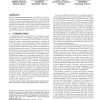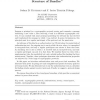154 search results - page 15 / 31 » Cryptographically Sound Theorem Proving |
CCS
2010
ACM
13 years 7 months ago
2010
ACM
Computational Indistinguishability Logic (CIL) is a logic for reasoning about cryptographic primitives in computational models. It captures reasoning patterns that are common in p...
PLDI
2011
ACM
12 years 10 months ago
2011
ACM
Program analysis and verification tools crucially depend on the ability to symbolically describe and reason about sets of program behaviors. Separation logic provides a promising...
CADE
2002
Springer
14 years 8 months ago
2002
Springer
Abstract. Proof-carrying code (PCC) allows a code producer to associate to a program a machine-checkable proof of its safety. In the original approach to PCC, the safety policy inc...
TCS
2002
13 years 7 months ago
2002
Suppose a principal in a cryptographic protocol creates and transmits a message containing a new value v, later receiving v back in a different cryptographic context. It can concl...
ASIACRYPT
2011
Springer
12 years 7 months ago
2011
Springer
The assumption of the availability of tamper-proof hardware tokens has been used extensively in the design of cryptographic primitives. For example, Katz (Eurocrypt 2007) suggests ...


